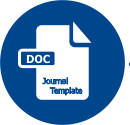Formulasi Fruit Bars Berbasis Tepung Pisang Ditinjau dari Karakteristik Fisik, Kimia dan Organoleptik
DOI:
https://doi.org/10.12928/jfc.v2i2.1437Keywords:
fruit bars, pisang kepok, pisang raja, pisang susuAbstract
Penelitian ini bertujuan untuk mengetahui formulasi serta karakteristik fisik, kimia dan organoleptik fruit bars berbahan dasar tepung buah pisang kepok, raja dan susu dengan penambahan tepung kedelai. Penelitian menggunakan rancangan acak lengkap dengan satu faktor yaitu penggunaan bahan dasar tepung pisang kepok, tepung pisang raja dan tepung pisang susu. Hasil penelitian menunjukkan bahwa fruit bars dari ketiga jenis pisang memiliki kadar air dan kadar serat yang tidak berbeda nyata, sedangkan pada rendemen adonan dan uji organoleptik menunjukkan hasil berbeda nyata. Rendemen adonan tertinggi pada perlakuan fruit bars dengan menggunakan bahan dasar tepung susu yaitu 0,88 g dan uji organoleptik fruit bars yang dapat diterima panelis adalah pada perlakuan fruit bars menggunakan bahan dasar pisang kepok.
References
Agung, dkk. 2017. Formulasi dan Karakteristik Nutrimat Bar Berbasis Tepung Kacang Kedelai (Glycine max. L) dan Tepung Kacang Merah (Phaseolus vulgaris. L) sebagai makanan pasien kemoterapiâ€, dalam Jurnal Gizi Indonesia. Vol. 5, No. 2 : 133-139.
Almasyhuri. 2012. Formulasi Biskuit Padat Siap-Santap Untuk Makanan Darurat, dalam Penel Gizi Makan. Vol. 35, No. 1: 42-48.
Baskar, dkk. 2016. Formulasi Pangan Darurat Berbentuk Food Bars Berbasis Tepung Millet Putih (Panicum milliaceum L.) dan Tepung Kacang Merah (Phaseolus vulgaris L.), dalam Journal Agritech. Vol. 36, No. 1: 23-29.
Cherry, J.P. and K.H. McWaters. 1981. Whippability and Aeration. In: J.P. Cherry. Protein Functionality in Foods. American Chemical Society. Washington D.C.
Ekafitri, R., & Isworo, R. (2014). Pemanfaatan Kacang-Kacangan sebagai Bahan Baku Sumber Protein Untuk Pangan Darurat, dalam Jurnal Pangan. Vol. 23, No. 2: 134144.
Fajri, dkk. 2013. Karakteristik Fisikokimia dan Organoleptik Food Bars Labu Kuning (Cucurbita mxima) Dengan Penambahan Tepung Kedelai dan Tepung Kacang Hijau Sebagai Alternatif Produk Pangan Darurat, dalam Jurnal Teknologi Hasil Pertanian. Vol. 6, No. 2: 103-110.
Fardiaz, S. 1992. Mikrobiologi Pengolahan Pangun Lanjut. Bogor: PAU Pangan dan Gizi Institut Pertanian Bogor.
Fatimah, P. S., E. Nasution, dan E. Y. Aritonang. 2013. Uji Daya Terima dan Nilai Gizi Biskuit yang Dimodifikasi dengan Tepung Kacang Merah, dalam Jurnal kesehatan Masyarakat. Vol. 2, No. 6: 1-7.
Ferawati. 2009. Formulasi dan Pembuatan Banana Bars Berbahan Dasar Tepung Kedelai, Terigu, Singkong dan Pisang Sebagai Alternatif Pangan Darurat. Bogor: ITB.
Hildayanti. 2012. Studi Pembuatan Flakes Jejawut (Setaria italica). Skripsi Jurusan Teknologi Pertanian. Fakultas Pertanian. Universitas Hasanudin Makasar.
Nio, Oey kam. 1992. Daftar Analisis Bahan Makanan. Jakarta : Balai Penerbit FKUI.
Nurfiliyah, S.A., dan Widjarnarko, S.B. 2014. Uji Efektifitas Pelepasan Retronasal Aroma Jeli Pisang Ambon Putih Terhadap Persepsi Kenyang Panelis Overweight dan Obesitas, dalam Jurnal Pangan dan Agroindustri. Vol. 2, No. 2: 9-15.
Nurhayati, dkk. 2018. Formulasi Food Bars Berbasis Tepung Ubi Jalar Ungu dan Pisang Agung (Musa paradisiaca formatypica) Masak, dalam Jurnal Agroteknologi. Vol. 12, No. 1: 71-78.
Pertiwi, A. D., Widanti, Y. A., & Mustofa, A. 2017. Substitusi Tepung Kacang Merah (Phaseolus vulgaris L.) pada Mie Kering dengan Penambahan Ekstrak Bit (Beta vulgaris L.), dalam Jurnal Teknologi dan Industri Pangan. Vol. 2, No. 1: 6773.
Putra, SR. 2013. Pengantar Ilmu Gizi dan Diet. D-Medika. Yogyakarta.
Ridla, M. 2014. Pengenalan Bahan Makanan. Bogor: Institusi Pertanian Bogor.
Winarno FG. 2008. Kimia Pangan. Jakarta : PT. Gramedia Pustaka Utama.
Downloads
Published
Issue
Section
License
Copyright (c) 2020 UNIVERSITAS AHMAD DAHLAN

This work is licensed under a Creative Commons Attribution-ShareAlike 4.0 International License.
Authors who publish with JOURNAL OF FOOD AND CULINARY agree to the following terms:
- All articles published are Open Access that means they will be immediately and permanently free for everyone to read and download. We use the CC-BY-SA license options under Creative Commons Attribution License (CC BY-SA 4.0). Creative Commons Attribution License (CC BY-SA 4.0). CC-BY-SA assures that all works will be available under CC-BY-SA always and no risk of commercial actions against the will of the copyright holder.
- Anyone can use, copy and disseminate the material in any medium or format; as well as re-use, re-mix, transform, and build upon the material for any purpose, even commercially. However, they must acknowledge the authors by giving appropriate credits (cite to the article or content), provide a link to the license, and indicate if changes were made and use under the same license as the original.
- Authors retain copyright and grant license exclusive rights in their article to Universitas Ahmad Dahlan as publisher of the JOURNAL OF FOOD AND CULINARY.
- Authors have the right to retain patent, trademark and other intellectual property rights (including research data).
- Authors have the right to proper attribution and credit for the published work.
Copyright Transfer Agreement
- The Authors submitting the manuscripts do so on the understanding that if they are accepted for publications, copyright of the articles shall be assigned to Universitas Ahmad Dahlan as publisher of the JOURNAL OF FOOD AND CULINARY.
- Universitas Ahmad Dahlan as publisher of The JOURNAL OF FOOD AND CULINARY, the Editors, and the Editorial Board Members of the JOURNAL OF FOOD AND CULINARY make every efforts to ensure that no wrong or misleading data, opinions or statements are published in the journal. In any way, the contents of the articles and circulars published in the JOURNAL OF FOOD AND CULINARY are the sole and exclusive responsibility of their respective authors and advertisers.
- The publisher may revoke the publication for violating the ethical code of conduct.





